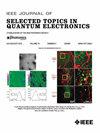用于自由空间激光通信的平面串联APD阵列
IF 5.1
2区 工程技术
Q1 ENGINEERING, ELECTRICAL & ELECTRONIC
IEEE Journal of Selected Topics in Quantum Electronics
Pub Date : 2025-10-03
DOI:10.1109/JSTQE.2025.3617509
引用次数: 0
摘要
扩大光电探测器(PD)的有效窗口尺寸,同时保持其高速和高响应性能是实现大视场角高性能光接收机应用于自由空间激光通信系统的关键。然而,在传统的PD结构中,较大的有源面积总是导致rc带宽的明显下降。使用串联布局的高速p-i-n PD阵列解决了这个问题,但它降低了高速和大视场性能的响应性,因为需要在不同的p-n结之间进行电流平衡。本文首次展示了新型串联APD阵列,该阵列放松了窗口大小、响应性和速度之间的基本权衡。我们的倒装芯片封装3 $ \times $ 3阵列,窗口尺寸为0.12 mm,可以同时实现高响应(1.2 a /W)、宽带(6 GHz)和大GBP (150 GHz)。本文章由计算机程序翻译,如有差异,请以英文原文为准。
Planar Tandem APD Array for Free Space Laser Communications Applications
Enlarging the active window size of the photodetector (PD) while sustaining its high-speed and high-responsivity performances is the key to achieving a high-performance photo-receiver with a large field-of-view (FoV) angle for application in a free space laser communication system. However, in the traditional PD structure, a large active area always leads to a pronounced degradation in the RC-bandwidth. Using a tandem layout for high-speed p-i-n PD arrays solves the problem, but it reduces the responsivity for high-speed and large FoV performance, as current balancing between the different p-n junctions is needed. Here, for the first time, novel tandem APD arrays are demonstrated which relax the fundamental trade-offs among window size, responsivity, and speed. Our flip-chip packaged 3 $ \times $
求助全文
通过发布文献求助,成功后即可免费获取论文全文。
去求助
来源期刊

IEEE Journal of Selected Topics in Quantum Electronics
工程技术-工程:电子与电气
CiteScore
10.60
自引率
2.00%
发文量
212
审稿时长
3 months
期刊介绍:
Papers published in the IEEE Journal of Selected Topics in Quantum Electronics fall within the broad field of science and technology of quantum electronics of a device, subsystem, or system-oriented nature. Each issue is devoted to a specific topic within this broad spectrum. Announcements of the topical areas planned for future issues, along with deadlines for receipt of manuscripts, are published in this Journal and in the IEEE Journal of Quantum Electronics. Generally, the scope of manuscripts appropriate to this Journal is the same as that for the IEEE Journal of Quantum Electronics. Manuscripts are published that report original theoretical and/or experimental research results that advance the scientific and technological base of quantum electronics devices, systems, or applications. The Journal is dedicated toward publishing research results that advance the state of the art or add to the understanding of the generation, amplification, modulation, detection, waveguiding, or propagation characteristics of coherent electromagnetic radiation having sub-millimeter and shorter wavelengths. In order to be suitable for publication in this Journal, the content of manuscripts concerned with subject-related research must have a potential impact on advancing the technological base of quantum electronic devices, systems, and/or applications. Potential authors of subject-related research have the responsibility of pointing out this potential impact. System-oriented manuscripts must be concerned with systems that perform a function previously unavailable or that outperform previously established systems that did not use quantum electronic components or concepts. Tutorial and review papers are by invitation only.
 求助内容:
求助内容: 应助结果提醒方式:
应助结果提醒方式:


